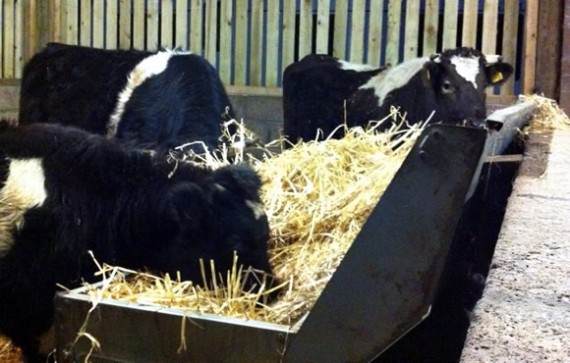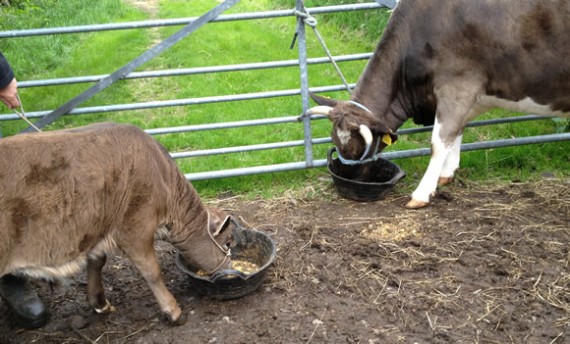Feeding cattle
Traditional breeds of cattle can manage perfectly well on grazing alone – in theory. However, it’s unlikely that, in practice, any cattle will have access to sufficient grazing, in terms of quantity or quality, to sustain them all year. During the winter months, when the grass isn’t growing, most cattle will need a supplementary feed of forage (straw, hay, haylage or silage).
 Feeding straw to our Shetland cattle
Feeding straw to our Shetland cattle
Depending on your soil, they will almost certainly benefit from access to additional minerals as well throughout the year. If you are breeding cattle, there are times when a cow or heifer may also need additional supplementation to avoid metabolic disorders – usually late pregnancy and early lactation.
 Coarse mix is a useful bribe to aid halter training cattle
Coarse mix is a useful bribe to aid halter training cattle
Additional minerals can be made available as licks, as drenches or as boluses, which are orally administered and lie in the rumen releasing minerals.
Don’t forget water – cattle drink a lot of water, particularly when being fed dry feed or when in milk.
How much land and feed?
As a rough estimate of the amount of land you will need, allow one acre of good grazing per cow for the summer. Double that if you are going to make your own forage for winter keep. Of course, if you are prepared to feed more forage, cattle can be kept on smaller acreages. You can read more about stocking rates in our Grassland Management section.
As a rough guide, the dry matter intake of cattle should be about 2.5% of bodyweight, but this is obviously affected by factors like stage of pregnancy and lactation. Cows in late pregnancy will have less room for bulky food, because of the growing calf, while cows in early lactation may require supplementation to avoid excessive loss of body condition.
In our first two winters, we fed our cattle hay. We use a wheeled, covered sheep hayrack, which works fine for small numbers. This year, 2012/13, we’re feeding straw. It’s half the price of hay and they seem to be doing fine on it. They also have access to a molassed feed lick.
When at grass, they have access to rock salt and a mineral lick. We also feed some coarse calf mix when we’re halter training – once they get a taste for it, it’s easy to bribe them. George almost puts his own halter on when he sees the bucket. :-)
Condition scoring
It’s advisable to become familiar with condition scoring. This is a technique used to assess the body condition of livestock. Cattle can lay down stores of fat when food is plentiful and mobilise it when the animal’s requirement for nutrition is not being met by the food consumed.
Body condition of breeding animals is particularly important at key times such as conception and late pregnancy. Inadequate feeding at conception can result in failure to conceive, as can being too fat. High feed intakes in the last third of pregnancy can result in a large calf and contribute to calving difficulties while after calving, the cow needs adequate nutrition to provide milk for her calf.
There will be further explanation of body condition scoring in the Breeding Cattle section.
- Previous « Transporting and handling cattle
- Next Housing cattle »

About Rosemary Champion
Rosemary lives on a 12 acre smallholding in Angus, in the east of Scotland, where she keeps Ryeland Sheep, Shetland cattle and assorted poultry. She was destined to be a smallholder from an early age.
Further Reading
 Caring for Cows Val Porter |  Practical Cattle Farming Kat Bazeley |  The Illustrated Guide to Cows Celia Lewis |  Cows for the Smallholder Val Porter |  |













